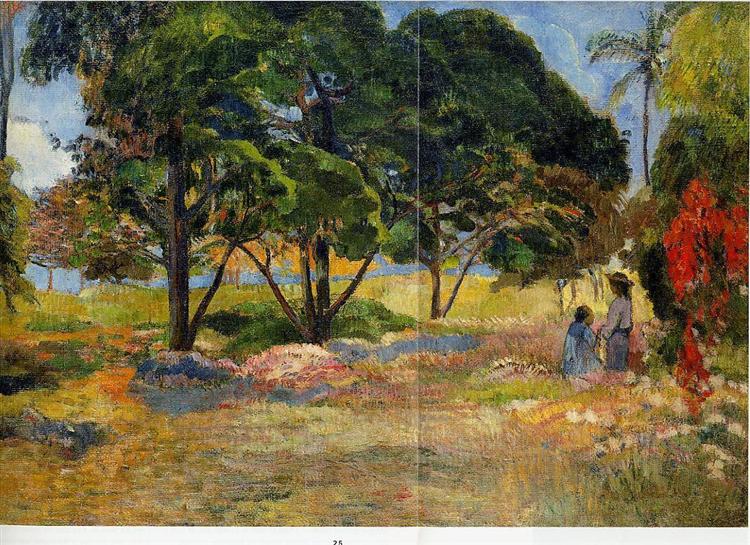Description
Paul Gauguin's Landscape with Three Trees (1892) is an iconic example of the post-impressionist style that characterizes much of his work and also challenges the conventions of the art of his time. An innovator in the use of color and form, Gauguin moved away from naturalistic representation to explore a more emotional and symbolic pictorial language. In this work, a duality is perceived between the observation of nature and a subjective interpretation of reality.
The composition is notable for its geometric simplicity. In the foreground, three trees stand with unmistakable firmness, dominating the landscape and acting almost as anthropomorphic figures that invite the viewer to experience the space differently. The arrangement of these trees, with their straight trunks and leafy canopy, suggests an almost meditative presence, as if they were stationed, observing the panorama that stretches out behind them. The horizontality of the landscape with gentle hills is complemented by the verticality of these trees, creating a dynamic tension in the work.
The use of color in “Landscape with Three Trees” is equally significant. Gauguin employs a vibrant and unconventional palette, where the deep greens of the trees contrast with the warm, earthy tones of the earth and sky. This color choice not only serves to delineate the forms but also establishes an almost dreamlike atmosphere, blurring the line between realism and fantasy. The vibrant blue of the sky and the subtle nuances of the vegetation suggest a particular light, perhaps evoking an emotional quality rather than an objective representation.
It is relevant to mention that there are no human characters in this work, which reinforces the sense of introspection and connection with nature. The absence of human figures can be interpreted as a call to perceive the landscape not only as a backdrop, but as a space that encourages meditation and reflection on existence and solitude. The choice not to include narrative elements can be related to Gauguin's tendency to rediscover and reimagine the environment in his search for a deeper truth.
Gauguin, who was a pioneer in his exploration of primitivist themes and bold use of color that went beyond mere representation, often sought out the spiritual essence of the places he portrayed. “Landscape with Three Trees” aligns with his desire to express a sense of place that transcends mere geography, suggesting that art has the power to evoke a richer, more meaningful emotional experience.
The work as a whole invites the viewer to meditate on the simplicity of natural life, and suggests a longing for a deeper connection with the surrounding world. In this dance between shapes and colors, Gauguin not only captures a landscape, but also offers us a mirror in which to reflect on our own relationship with the natural environment. Through "Landscape with Three Trees," Gauguin establishes himself as a master at creating spaces that transcend the visual, reaching out to touch the emotional and spiritual.
KUADROS ©, a famous painting on your wall.
Hand-made oil painting reproductions, with the quality of professional artists and the distinctive seal of KUADROS ©.
Painting reproduction service with satisfaction guarantee. If you are not completely satisfied with the replica of your painting, we will refund 100% of your money.

